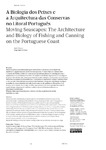Mostrar o rexistro simple do ítem
Moving Seascapes: The Architecture and Biology of Fishing and Canning on the Portuguese Coast
| dc.contributor.author | Tavares, André | |
| dc.contributor.author | Souza, Diego Inglez de | |
| dc.date.accessioned | 2022-03-31T12:57:06Z | |
| dc.date.available | 2022-03-31T12:57:06Z | |
| dc.date.issued | 2021-12-31 | |
| dc.identifier.citation | Tavares, André, and Diego Inglez de Souza. 2021. “Moving Seascapes: The Architecture and Biology of Fishing and Canning on the Portuguese Coast”. BAC Boletín Académico: Revista de investigación y Arquitectura contemporánea 11 (December). A Coruña:14-31. https://doi.org/10.17979/bac.2021.11.0.7413 | es_ES |
| dc.identifier.issn | 2173-6723 | |
| dc.identifier.issn | 0213-3474 | |
| dc.identifier.uri | http://hdl.handle.net/2183/30348 | |
| dc.description.abstract | [Abstract] When they fish, humans play an active part in the dynamics of marine ecosys-tems, and architecture is subsequently involved in the processing of their catch. Our goal is to develop the idea of Fishing Architecture as a useful concept for understanding the interconnected relationship between architecture and fish-ing. By analysing the architectural and ecological outcomes of fisheries and can-ning industry, we will try to assess the complex relationship between human ac-tivities and environmental transformations. How can we represent the intricate relationship between the sea and the coast? This text seeks to state this hypothe-sis and incorporate ecological information into the analysis of the development of the sardine canning industry in Matosinhos. Based on the knowledge of ma-rine ecology, we hope to find an original perspective from which to visualize and evaluate urban developments and their environmental impacts. | es_ES |
| dc.description.abstract | [Resumo] Através da pesca, os humanos participam activamente na dinâmica dos ecossistemas marinhos e a arquitectura está envolvida nesse processo. O nosso objectivo é desenvolver o conceito de Fishing Architecture como uma noção útil para descrever a interligação entre a arquitectura e os ecossistemas marinhos. Ao analisar os resultados arquitectónicos e ecológicos da pesca e da indústria das conservas, tentaremos avaliar a relação complexa entre as actividades humanas e as transformações ambientais. Como podemos representar a relação intrincada entre o mar e a costa? Este texto procura enunciar esta hipótese e incorporar a informação ecológica na análise do desenvolvimento da indústria de conservas de sardinha em Matosinhos. Com base no conhecimento da ecologia marinha, esperamos encontrar uma perspectiva original a partir da qual seja possível visualizar e avaliar os desenvolvimentos urbanos e os seus impactos ambientais. | es_ES |
| dc.language.iso | eng | es_ES |
| dc.language.iso | por | es_ES |
| dc.publisher | Universidade da Coruña | es_ES |
| dc.relation.uri | https://doi.org/10.17979/bac.2021.11.0.7413 | es_ES |
| dc.rights | Atribución-NoComercial-CompartirIgual 4.0 Internacional (CC BY-NC-SA 4.0) | es_ES |
| dc.rights.uri | https://creativecommons.org/licenses/by-nc-sa/4.0/ | |
| dc.subject | Fishing architecture | es_ES |
| dc.subject | Marine biology | es_ES |
| dc.subject | Industrial architecture | es_ES |
| dc.subject | Seascapes | es_ES |
| dc.subject | Ecology | es_ES |
| dc.subject | Arquitetura da pesca | es_ES |
| dc.subject | Biologia marinha | es_ES |
| dc.subject | Arquitetura industrial | es_ES |
| dc.subject | Marinhas | es_ES |
| dc.subject | Ecologia | es_ES |
| dc.title | Moving Seascapes: The Architecture and Biology of Fishing and Canning on the Portuguese Coast | es_ES |
| dc.title.alternative | A Biologia dos peixes e a Arquitectura das conservas no litoral português | es_ES |
| dc.type | info:eu-repo/semantics/article | es_ES |
| dc.rights.access | info:eu-repo/semantics/openAccess | es_ES |
| dc.date.updated | 2022-03-30T12:21:50Z | |
| UDC.journalTitle | BAc Boletín Académico. Revista de investigación y arquitectura contemporánea | es_ES |
| UDC.volume | 11 | es_ES |
| UDC.startPage | 14 | es_ES |
| UDC.endPage | 31 | es_ES |
| dc.identifier.doi | 10.17979/bac.2021.11.0.7413 |






